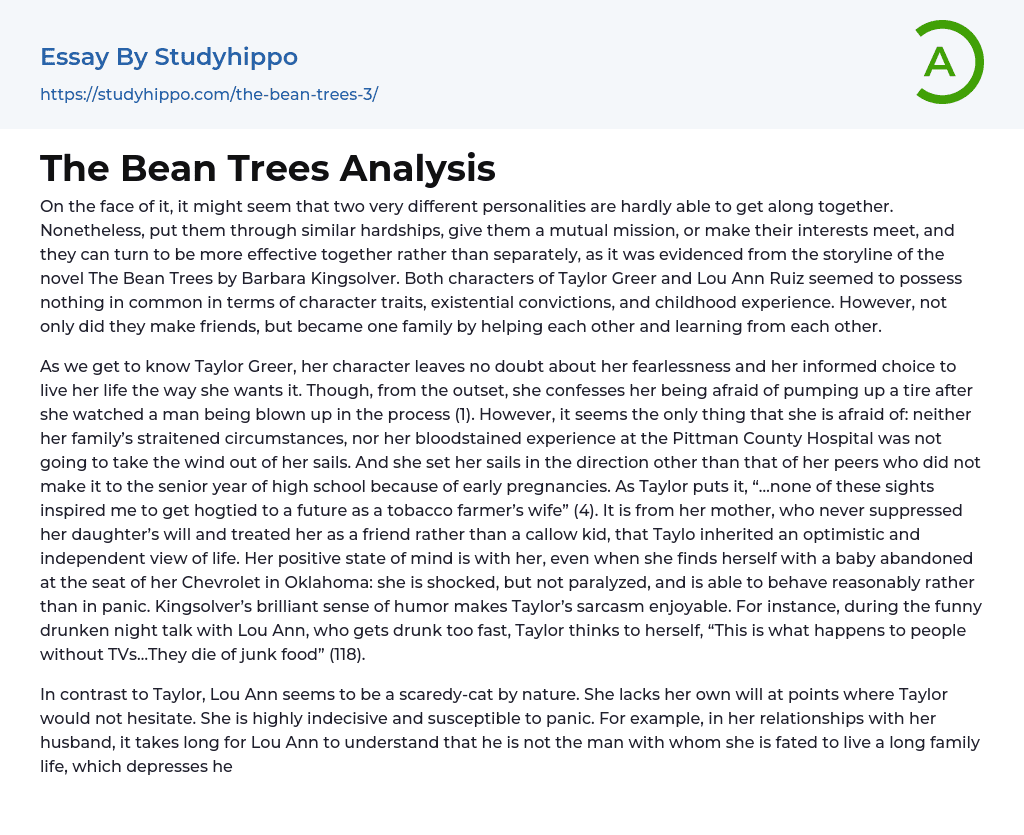On the face of it, it might seem that two very different personalities are hardly able to get along together. Nonetheless, put them through similar hardships, give them a mutual mission, or make their interests meet, and they can turn to be more effective together rather than separately, as it was evidenced from the storyline of the novel The Bean Trees by Barbara Kingsolver. Both characters of Taylor Greer and Lou Ann Ruiz seemed to possess nothing in common in terms of character traits, existential convictions, and childhood experience. However, not only did they make friends, but became one family by helping each other and learning from each other.
As we get to know Taylor Greer, her character leaves no doubt about her fearlessness and her informed choice to live
...her life the way she wants it. Though, from the outset, she confesses her being afraid of pumping up a tire after she watched a man being blown up in the process (1). However, it seems the only thing that she is afraid of: neither her family’s straitened circumstances, nor her bloodstained experience at the Pittman County Hospital was not going to take the wind out of her sails. And she set her sails in the direction other than that of her peers who did not make it to the senior year of high school because of early pregnancies. As Taylor puts it, “…none of these sights inspired me to get hogtied to a future as a tobacco farmer’s wife” (4). It is from her mother, who never suppressed her daughter’s will and treated her as a friend rather than a callow kid, that Tayl
inherited an optimistic and independent view of life. Her positive state of mind is with her, even when she finds herself with a baby abandoned at the seat of her Chevrolet in Oklahoma: she is shocked, but not paralyzed, and is able to behave reasonably rather than in panic. Kingsolver’s brilliant sense of humor makes Taylor’s sarcasm enjoyable. For instance, during the funny drunken night talk with Lou Ann, who gets drunk too fast, Taylor thinks to herself, “This is what happens to people without TVs…They die of junk food” (118).
In contrast to Taylor, Lou Ann seems to be a scaredy-cat by nature. She lacks her own will at points where Taylor would not hesitate. She is highly indecisive and susceptible to panic. For example, in her relationships with her husband, it takes long for Lou Ann to understand that he is not the man with whom she is fated to live a long family life, which depresses her immensely, for she firmly believes that a man and a marriage are for life, as she confessed to Taylor on that drunken night (117). Besides, no other options are considered to be acceptable by her mother and grandmother, who are strong in their prejudices and behave very authoritative towards Lou Ann. It has surely affected the way Lou Ann learned to accept herself from the very childhood. Such her traits as the dissatisfaction with her own appearance, possession by the authoritative opinion, and making a mountain out of a molehill can really get on one’s nerves, given that she is an attractive woman. Moreover, not a single of her highly sensitive assumptions confirmed. As Lou
Ann trusted the authors’ word for all they said in scholar magazines on the subject of childrearing, Taylor rightfully and smartly remarked, “Hell, for Lou Ann, would naturally be a place filled with sharp objects and small round foods” (145).
Despite all that, their friendship proved that Taylor’s arrogance could not serve as the answer to all the hardships in life, and Lou Ann’s blowing things out of proportion did not mean that she was silly. It is due to the latter’s good knowledge of people, complaisance, and respect for elders rather than silliness that prevented her from contradicting people. Otherwise, she would not choose the grumpy old neighbor as a babysitter for the kids. Furthermore, Taylor’s internal freedom positively influenced Lou Ann in terms of communication with people: Lou Ann eventually found a job, managed to hold on to it, and even was promoted, though the work was incredibly hard. For Taylor, it was to a large extent Lou Ann’s unexpected persistence on the issue of Turtle’s adoption that supported Taylor when she lost her heart.
Thus, it becomes crystal clear that humane characters cannot be flat. They develop in the course of human relations, learn from each other, and supplement one another, as illustrated by the relationship of Taylor and Lou Ann. Both characters are upcoming, human, lively, and, therefore, engaging.
- John Locke essays
- 9/11 essays
- A Good Teacher essays
- A Healthy Diet essays
- A Modest Proposal essays
- A&P essays
- Academic Achievement essays
- Achievement essays
- Achieving goals essays
- Admission essays
- Advantages And Disadvantages Of Internet essays
- Alcoholic drinks essays
- Ammonia essays
- Analytical essays
- Ancient Olympic Games essays
- APA essays
- Arabian Peninsula essays
- Argument essays
- Argumentative essays
- Art essays
- Atlantic Ocean essays
- Auto-ethnography essays
- Autobiography essays
- Ballad essays
- Batman essays
- Binge Eating essays
- Black Power Movement essays
- Blogger essays
- Body Mass Index essays
- Book I Want a Wife essays
- Boycott essays
- Breastfeeding essays
- Bulimia Nervosa essays
- Business essays
- Business Process essays
- Canterbury essays
- Carbonate essays
- Catalina de Erauso essays
- Cause and Effect essays
- Cesar Chavez essays
- Character Analysis essays
- Chemical Compound essays
- Chemical Element essays
- Chemical Substance essays
- Cherokee essays
- Cherry essays
- Childhood Obesity essays
- Chlorine essays
- Classification essays
- Cognitive Science essays




